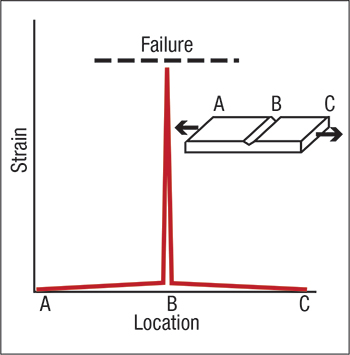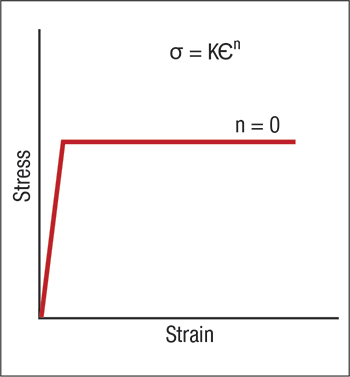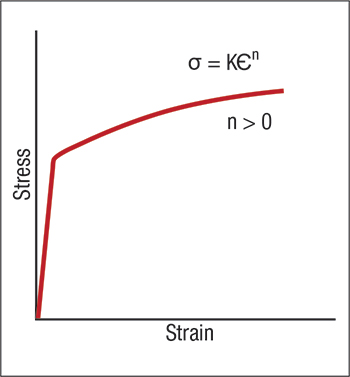A Graphical Explanation of n-Value
November 1, 2016Comments
Studying the various properties of steels and other metal alloys, one property stands out as the best and most powerful: the workhardening exponent (n-value). This property, obtained from the stress-strain curve, cannot be measured as a single point, as can tensile strength. Instead, many data points from 10- to 20-percent strain in the stress-strain curve are used to develop the n-value equation. Traditional high-strength low-alloy (HSLA) steels have used this n-value since the 1970s. For these steels, n-values are mostly constant or have a narrow range. In contrast, the n-values of advanced high-strength steels (AHSS) are constantly changing and are measured and reported as the instantaneous n-value. 
Fig. 1—Any reduction in thickness will create a higher local stress compared to other areas.
The purpose of the n-value is to increase the strength of the steel as it deforms. Fig. 2 shows that n-values of zero cause deformation to increase without any increase in stress or strength. Zones A and C do nothing because all of the deformation occurs in area B. The high concentration of deformation in area B forms a gradient—a narrow localization of strain that can reach very high peak strains (Fig. 3). Failure is easily reached.
Now assume that the entire strip has an n-value. The steel will start to workharden and increase the stress required for deformation (Fig. 4). Deformation starts at area B. After a small increase in height in area B, areas A and C start to deform and reach the strength of area B. Deformation then continues as areas A, B and C move to higher levels of strain. The higher the strain of the entire location the less importance the bump has in creating failure.
Next month, we will discuss how n-values for AHSS are quite different than those for HSLA steels. MF
View Glossary of Metalforming Terms
Technologies: Materials, Quality Control
Comments
Must be logged in to post a comment. Sign in or Create an Account
There are no comments posted. Quality Control
Quality ControlAmrol Jr. New Starrett President and CEO, Other Executives N...
Wednesday, March 5, 2025
Ascential Technologies Appoints Divisional CEO to Specialty ...
Wednesday, April 24, 2024
 Materials
MaterialsBrinell, Rockwell and Vickers Hardness Testing: Use and Misu...
Daniel Schaeffler Friday, April 1, 2022
 Quality Control
Quality ControlTroubleshooting Sheet Metal Forming Problems, Part 2: The St...
Daniel Schaeffler Friday, February 26, 2021










